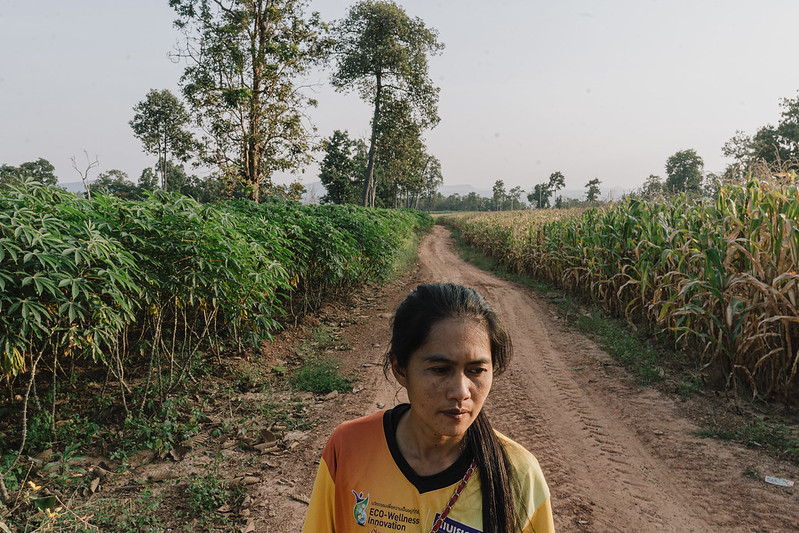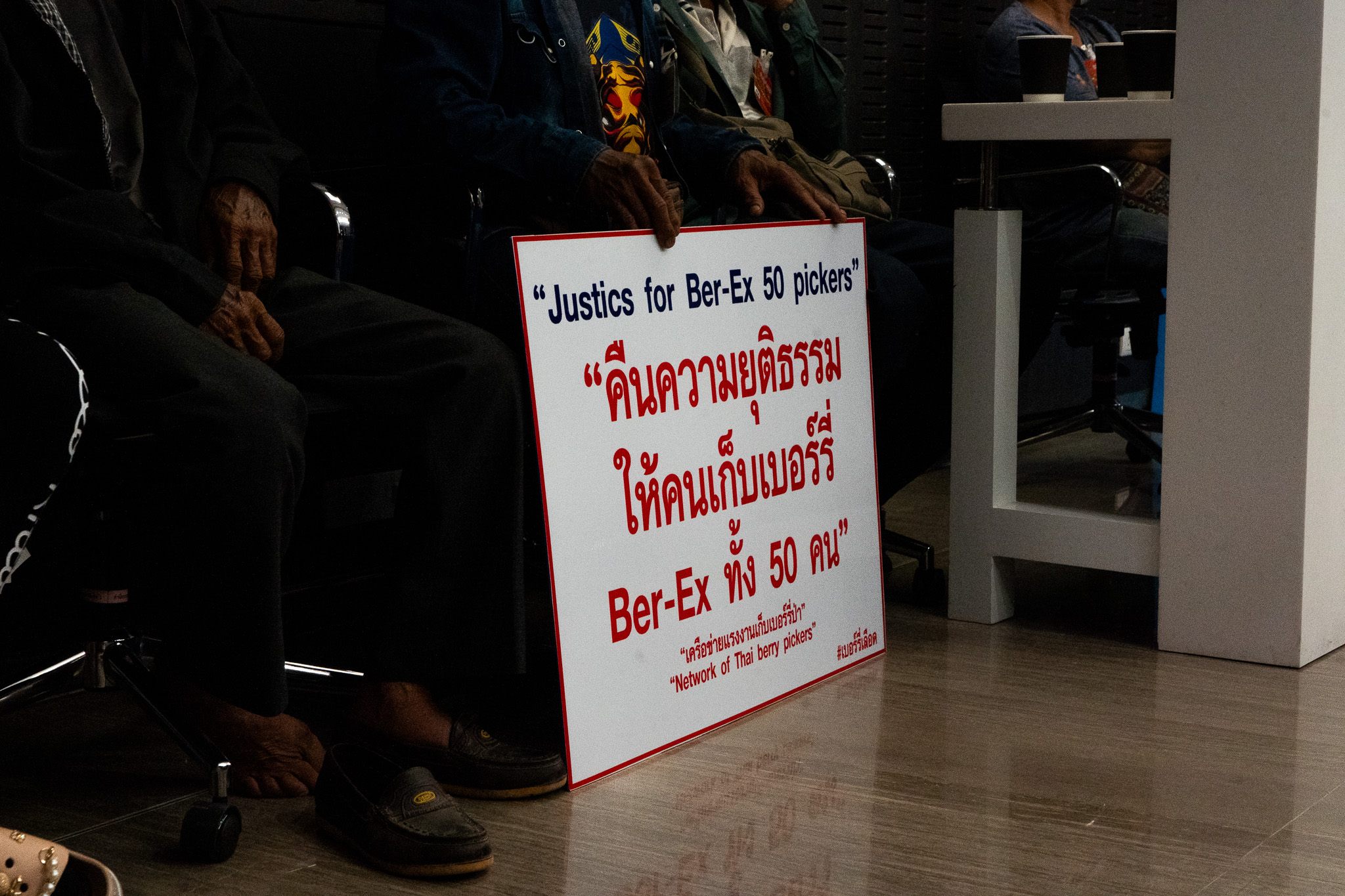
Story by Donlawat Sunsuk
Photos by Supaporn Tamprakon
The rice fields turned yellow in the middle of November, waiting to be harvested. Cold winds signal that the rainy season has ended. That means preparations for new performances by molam performers have begun.
Unable to perform crisis due to the government’s COVID-19 restrictions to prevent the spread of the disease at the beginning of this year, the Siang Isaan molam troupe has now resumed performances. Each year, including this one, they take time to prepare new performances.
Molam and LGBT+ lovers
At 7 p.m., more than 80 dancers are busy backstage applying makeup and preparing costumes inside more than 20 tents, with more than 20 costumes and sets of decorations.
A lesbian couple, Patthanakan “Pam” Kraisi, 31, and Kanyawee “Noi” Mipantong, 39, are busy with each other’s makeup and hair in preparation for the night’s performance. On the other side of the tent, a boy sits and plays with a mobile phone.
“This is my son,” Noi says, introducing her son. “His name is Time and he’s studying in the fifth grade. Pam has helped me raise him since he was two years old, and now he’s 11.”

Pam and Noi have been together for nine years after Noi separated with her husband while her son was only two years old. The couple lives together with the Siang Isaan troupe.
“I used to be married to a guy and had a child with him,” Noi explains. “First I thought we would be able to sustain the relationship, but I didn’t like his words and actions. I felt like he was taking advantage of me and so we didn’t understand one another and eventually we broke up. After that, I met Pam and felt like she understood me and we could talk about everything, so we decided to get together. I’ve always been someone who likes tomboys.”
Pam says she also feels comfortable with Noi, resulting in the decision for them to start a family together. “I like women,” she says, “and when I met her, I felt comfortable talking to her. It’s like I’m myself, and it makes me like her.”

Coming out after joining the troupe
After finishing high school, 18-year-old Pam left her home in Sisaket and came to Udon Thani. Out of personal interest and curiosity about the way of life of molam performers, she applied for a job at the Siang Isaan molam troupe.
“On the first day of work, I didn’t like to dress up like a typical woman,” Pam says. “I just wanted to see how molam performers lived, and so I started out with costumes.”
Then, the leader of the troupe, Urai Chimluang, better known as Nok Noi Uraiporn, 63, encouraged Pam to dance. “I didn’t know how to dance,” Pam says. “I didn’t know that I could dance until I tried.”

Before leaving her home, Pam still lived her life as a straight woman, for fear that her family would not understand.
A decade ago, she says, society still wasn’t that open towards LGBTQ+ people like nowadays, and she was afraid that she would be seen as different. But she found the molam troupe to be gender diverse and accepting, a place where people were able to express themselves without having to be concerned. The warm attitude at the troupe made her feel brave enough to come out.
Pam says that at first, “there were more than 100 female dancers, and many were lesbians, so I had the courage to come out. Before that, I was afraid to come out. I just knew that I liked girls, but all I ever did was look at them.”
After working with the Siang Isaan troupe for three years, Pam came out as a lesbian. She first cut her hair short and had a girlfriend. But she worried what her parents would say.
“When I first came out, my parents didn’t accept me because they were afraid that people would gossip,” she says. “But when I showed them that I was able to take care of myself and the family, they were more accepting. The molam community accepts everyone regardless of their gender.”
The molam troupe: a safe space for gender diversity
A day before the performance, The Isaan Record visited the headquarters of the Siang Isaan toupe in Udon Thani. The two-storey house was full of equipment and costumes. One part of the house is used to decorate and make alterations on clothing for performances.
Fifty-five-year-old Thanawat Methawong, the troupe’s manager and a costume designer, is busy decorating a costume that will be used for a performance on the next day.
“Siang Isaan initially didn’t have any male dancers,” he says. “We had only women because that was the policy of the troupe owners. However, we started accepting male dancers during the past seven or eight years in order to increase the variety of shows. We were almost the last troupe to change the policy.”
Thanawat says there’s a wide gender diversity among male performers. The first year the troupe started accepting male dancers, six of the 22 male dancers were straight, while 16 were LGBTQ+. In recent years, almost all of them have been LGBTQ+ people.
Thanawat says, “I think why there are so many LGBTQ+ people in molam troupes is because when they get together, they are able to talk about everything. They face similar problems and are able to overcome gender bias. We don’t take into account gender differences but give importance to people’s skills.”

Molam is the family of diversity
Kongphap “Stamp” Bunyeun, 27, is the lead male dancer who joined the troupe at the age of 18. He hoped that working with the troupe would help him show his full potential.
Another reason is that he wanted to be among LGBTQ+ people.

“I applied to become a member of the troupe because I thought it would suit me,” he says. “I also wanted to be able to hang out with people who are like me. Now it’s the ninth year and I feel at home, like a family.”
Stamp says LGBTQ+ people understand each other and can talk about everything, whether in this troupe or others, which is the reason why he thinks molam is fitting for LGBTQ+ people.

Comedy and the third gender
The popularity of the Siang Isaan molam troupe rose to its peak around 2007 when it had up to 450 members and more than 10,000 people attending its performances.
One of its most popular performances is its cross-gender comedy shows which features LGBTQ+ actors, especially katoeys like Poi Fai Malaiporn, Yai Juen, and Yai Laem who frequently draw laughter and bring color to the stage.

Duangchan Malai or Poi Fai, a singer and former comedian at Siang Isaan, said she prefers to perform as a katoey because it can be more flexible in terms of acting, which is why she dresses as a katoey during performances. She feels “katoey” represents modernity and frankness.
Poi Fai says “katoey” represent fun that make for fun performances on stage and is the reason why she acts as a katoey.
“In the past, society was not this open and it wasn’t that acceptable,” she says. “But in the entertainment sector, gender diversity has long been present in molam and likay. Nowadays society is more open and everyone has the courage to express themselves.”

On stage, all genders are equal
The speaker on stage blares out: “Molam Isaan, 555 Ban Nong Sai, tambon Na Kam, Muang district, Udon Thani province. Nok Noi Uraiporn at 9 p.m.”
The announcement signals the start of the show.
Siang Isaan is now in its 46th year, led by Nok Noi Uraiporn.
This year, Siang Isaan did not hold any performances due to COVID-19, resulting in a lack of income since February.
“We almost disbanded,” Nok Noi says. “But we had people who used to work with us who came to help us out and bring back Siang Isaan.”
As Nok Noi is preparing for the night’s show, she says, “Here we give importance to people’s skills and sincerity. We don’t care about what your gender is.”
She admits that in the past, society did not accept gender diversity. When the troupe was first set up, it had only female dancers. Nok Noi feels the troupe offers a chance for LGBTQ+ people. It is a place where they can showcase their talent.
“In the past, LGBTQ+ people would be afraid of coming out,” she says. “But nowadays, society is more accepting and everyone is able to express themselves. I personally admire them for being confident and working the best they can. These days society gives an equal chance for everyone.”





